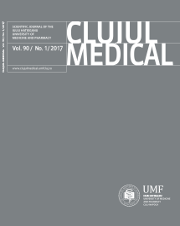1.5-Tesla Multiparametric-Magnetic Resonance Imaging for the detection of clinically significant prostate cancer
DOI:
https://doi.org/10.15386/cjmed-690Keywords:
Prostate cancer, Multiparametric-MRI, Cancer imaging, 1.5-T MRIAbstract
Background and aims. Multiparametric-magnetic resonance imaging (mp-MRI) is the main imaging modality used for prostate cancer detection. The aim of this study is to evaluate the diagnostic performance of mp-MRI at 1.5-Tesla (1.5-T) for the detection of clinically significant prostate cancer.
Methods. In this ethical board approved prospective study, 39 patients with suspected prostate cancer were included. Patients with a history of positive prostate biopsy and patients treated for prostate cancer were excluded. All patients were examined at 1.5-T MRI, before standard transrectal ultrasonography–guided biopsy.
Results. The overall sensitivity, specificity, positive predictive value and negative predictive value for mp-MRI were 100%, 73.68%, 80% and 100%, respectively.
Conclusion. Our results showed that 1.5 T mp-MRI has a high sensitivity for detection of clinically significant prostate cancer and high negative predictive value in order to rule out significant disease.
Downloads
Additional Files
Published
How to Cite
Issue
Section
License
The authors are required to transfer the copyright of the published paper to the journal. This is done by agreeing to sign the Copyright Assignment Form. Whenever the case, authors are also required to send permissions to reproduce material (such as illustrations) from the copyright holder.

The papers published in the journal are licensed under a Creative Commons Attribution-NonCommercial-NoDerivatives 4.0 International License.

